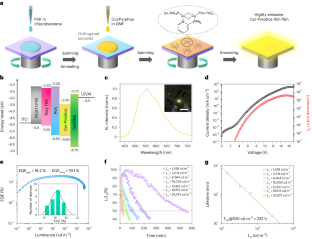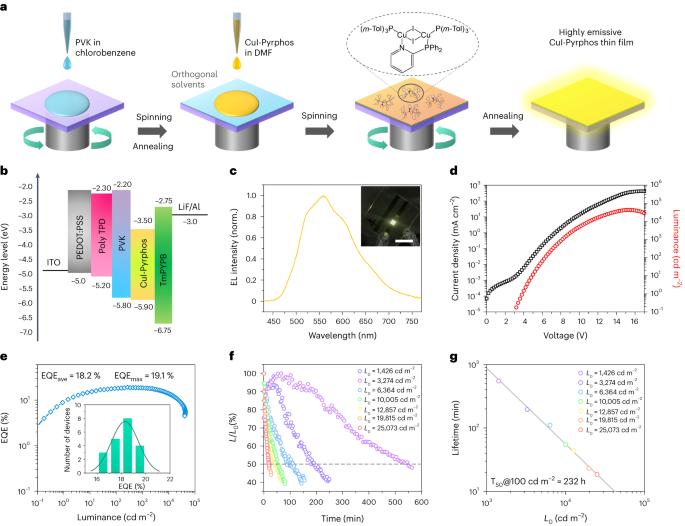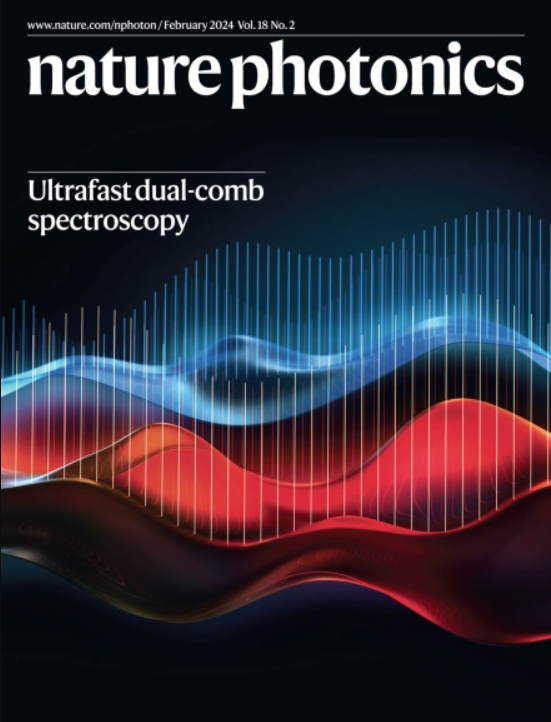基于铜-碘化物簇的高效暖白色发光二极管
IF 32.9
1区 物理与天体物理
Q1 OPTICS
引用次数: 0
摘要
基于铜-碘化物团簇的溶液加工发光二极管(LED)因其丰富性、环保性和高发光效率而成为固态照明的理想候选材料。然而,这类发光二极管的发展受到了阻碍,原因是簇的不稳定性、溶液兼容性差和薄膜质量低,导致器件性能不佳。在此,我们报告了一种新型的铜-碘化物杂化团簇,其官能团有助于提高团簇的溶解性和稳定性。这种杂化团簇在溶剂中表现出很高的结构稳定性,使溶液加工的薄膜表面粗糙度低至 0.22 nm,光致发光量子产率高达 70% 以上。我们将这种高质量薄膜用作暖白色 LED 的发射层,结果表明其最大外部量子效率为 19.1%,最大高亮度超过 40,000 cd m-2,工作寿命长达 232 h(初始亮度为 100 cd m-2 时的 T50)。我们还通过叶片涂层展示了亮度高达约 60,000 cd m-2 的大面积发光二极管,以及一系列基于配体修饰的可调色发光二极管。我们的研究结果表明,基于碘化铜簇的发光二极管在面板显示和固态照明的实际应用中具有巨大的潜力。本文章由计算机程序翻译,如有差异,请以英文原文为准。


High efficiency warm-white light-emitting diodes based on copper–iodide clusters
Solution-processed light-emitting diodes (LEDs) based on copper–iodide clusters are promising candidates for solid state lightings due to their abundance, environmental friendliness and high luminescent efficiency. However, the development of this class of LEDs is hampered by the instability of the clusters, poor solution compatibility and low film quality, resulting in poor device performances. Here we report a new type of copper–iodide cluster hybrids with functional groups that facilitate both solubility and stability of the clusters. The hybrid clusters exhibit high structural stability in solvents, enabling smooth solution-processed thin films with low surface roughness of 0.22 nm and high photoluminescence quantum yields of over 70%. We employ the high-quality thin film as an emissive layer in warm-white LEDs, showing a maximum external quantum efficiency of 19.1%, maximum high brightness of over 40,000 cd m−2 and a good operational lifetime of 232 h (T50 at an initial luminance of 100 cd m−2). We also demonstrate a large-area LED with brightnesses of up to ~60,000 cd m−2 through blade-coating and a series of colour-tunable LEDs based on ligand modifications. Our results suggest great potential of copper–iodide cluster-based LEDs for practical applications in panel display and solid-state lighting. Solution-processed copper–iodide clusters are employed as efficient emitters for warm white LEDs with external quantum efficiency of 19.1%.
求助全文
通过发布文献求助,成功后即可免费获取论文全文。
去求助
来源期刊

Nature Photonics
物理-光学
CiteScore
54.20
自引率
1.70%
发文量
158
审稿时长
12 months
期刊介绍:
Nature Photonics is a monthly journal dedicated to the scientific study and application of light, known as Photonics. It publishes top-quality, peer-reviewed research across all areas of light generation, manipulation, and detection.
The journal encompasses research into the fundamental properties of light and its interactions with matter, as well as the latest developments in optoelectronic devices and emerging photonics applications. Topics covered include lasers, LEDs, imaging, detectors, optoelectronic devices, quantum optics, biophotonics, optical data storage, spectroscopy, fiber optics, solar energy, displays, terahertz technology, nonlinear optics, plasmonics, nanophotonics, and X-rays.
In addition to research papers and review articles summarizing scientific findings in optoelectronics, Nature Photonics also features News and Views pieces and research highlights. It uniquely includes articles on the business aspects of the industry, such as technology commercialization and market analysis, offering a comprehensive perspective on the field.
 求助内容:
求助内容: 应助结果提醒方式:
应助结果提醒方式:


